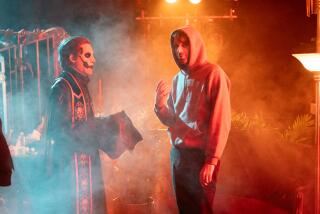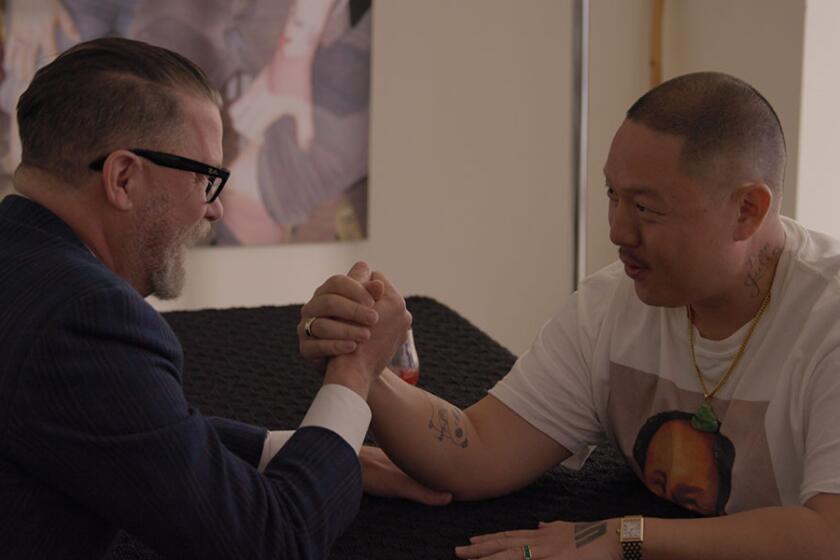‘Berberian Sound Studio’ picks up the sounds of violence
No blood is spilled or flesh ripped on screen in “Berberian Sound Studio,” Peter Strickland’s disturbing satirical thriller about the dubbing of a ferocious horror movie made in the style of giallo directors such as Mario Bava, Pupi Avati and Dario Argento. Instead, all the violence is aural.
The film combines the sounds of atrocities of the kind imagined by Edgar Allan Poe (achieved by the mutilation of vegetables in Foley work), plus eldritch wailings and warblings, unearthly screams and the eeriest of music — mostly provided by James Cargill of the indie electronic band Broadcast. Possibly not since Brian De Palma’s “Blow Out” in 1981 has a movie been driven by sound as radically as “Berberian Sound Studio,” named for Cathy Berberian, the late avant-garde soprano and composer.
The infernal noises torment the protagonist, Gilderoy (Toby Jones), a timid English sound designer and Foley artist of the 1970s, who has been hired by the surly Italian producer Coraggio (Cosimi Fusco) and his womanizing director, Santini (Antonio Manini), to create the dub for “The Equestrian Vortex,” a shocker about witches menacing the girl pupils of a riding academy.
PHOTOS: Hollywood Backlot moments
Opening in theaters and available on VOD on June 14, Strickland’s second feature is a parable about violence’s capacity to inflict psychological damage. Thematically, it follows in the footsteps of his 2009 debut, the quiet, gothic rape revenge drama “Katalin Varga,” which the Hungary-based filmmaker shot in Transylvania.
All but a few seconds of “The Equestrian Vortex” are unseen by the viewer. “I felt I would have been defeated if I’d shown all that horror,” Strickland said. “I have a genuine fondness for giallos. They were fun — there’s no other word for it — and very poetic. But there was an ethical, hopefully not didactic, reason for doing ‘Berberian.’ When directors try to outdo each other to see who can do the heaviest, most outlandish violence, and when they hide behind moral high ground by saying they’re trying to show how terrible violence is, it winds me up.
“When I talk to people about that I get two reactions. One is that ‘violence has no influence,’ the other is ‘violence is terrible and corrupts you.’ What about something in the middle? I don’t think violent films should be banned, but it should be acknowledged that the violent image is incredibly powerful and can desensitize some people.”
Gilderoy, who usually dubs children’s TV programs and nature films in the garden shed of the home he shares with his mother in bucolic Surrey, is appalled not only by the sounds he creates but the images he sees.
Said Jones: “The script gave me a feeling for innocence being thrown into decadence, corruption and something rotten deep in the heart of the film that seems to be percolating throughout Gilderoy’s whole life suddenly and destroying everything he believes. Even the letters he receives from his mother are about everything falling apart.”
His paranoia stoked by the recording crew’s contempt, Gilderoy starts to hallucinate and unravel. That’s supposing he makes the trip to Italy in the first place — Strickland and Jones both allow that Gilderoy’s nightmarish experience could be imaginary.
Strickland, 40, is a music concrète aficionado who in 1996 launched his own group, the Sonic Catering Band, to record the sound of food cooking. He became entranced by the sonically sophisticated soundtracks composed for giallos by the likes of Ennio Morricone, Bruno Maderna, Bruno Nicolai and the band Goblin.
“I started to realize how integral avant-garde music is to exploitation cinema, how horror lends itself to dissonance, atonal music and music concrète,” he said. “I think the best example of that would be Morricone’s soundtrack for [Dario] Argento’s ‘The Bird With the Crystal Plumage’ [1970] and Wayne Bell and Tobe Hooper’s for Hooper’s ‘The Texas Chainsaw Massacre’ [1974]. You could play the ‘Texas Chainsaw’ soundtrack in a concert hall and people would prick up their ears.”
The Anglo-Greek director said the soundtracks for both his films “took their cue” from the French composer Luc Ferrari’s concrète masterpiece “Presque rien No. 1” (1970). “It’s mostly a field recording,” he notes, “but it taught me so much about perspective and editing and foregrounding and distance, and how to achieve a sense of space in a sound mix — for example, hearing dogs bark at night and trying to capture that certain echo.”
The key influence on “Berberian Sound Studio,” he says, was “listening to [the soprano-composer] Cathy Berberian’s ‘Visage’ — this 21-minute piece of sound poetry, consisting of very intense howling, intended only for avant-garde circles” — which was recorded and edited by her husband, Luciano Berio, in Milan’s RAI studio in 1961. “I always thought it could be amazing in a horror film. You can imagine someone like that making money on the side by doing a session for a movie.”
During the course of “Berberian Sound Studio,” avant-garde vocalists arrive to contribute to “The Equestrian Vortex” dub — performance artist Katalin Ladik ululates as a vengeful witch, free jazz improviser Jean-Michael van Schouwburg snorts and gurgles as a dangerously aroused goblin.
PHOTOS: Celebrities by The Times
“These artists are not changing their performances or watering them down,” Strickland said. “All they’re doing is changing the context of what they do. That’s paralleled with the Foley artists, who are not changing the sound of a cabbage being stabbed, which is what you hear in a kitchen, but the context again. By switching the association in your mind, it becomes very powerful.”
Asked if he was affected by doing the Foley work while imagining “The Equestrian Vortex’s” stabbings and slashings, Jones said, “I had to be in, in order for it to play. I had to have a fairly clearly idea about the kind of thing I was looking at and, indeed, the sound helped me have a clear image of that.
“The more challenging part was to make it interesting for the viewer, who is constantly denied something I keep seeing,” he added. “It’s a paradox that’s probably linked to the way we see radio incredibly clearly. I’m sure we could see the quality of a radio drama by looking at the response of someone watching it.”
Because of Strickland’s enthusiasm for creating layered sound designs for both “Berberian Sound Studio” and the nonexistent “Equestrian Vortex,” supervising sound editor Joakim Sundström said, “As a sound nerd, it was a once-in-a-lifetime project — this is the one you’d want to do.”
Even the scenes depicting Foley work had to be Foleyed like any other scene. “Obviously we had to Foley ‘Berberian’ more realistically than ‘Equestrian,’ which we approached in a more ‘60s-’70s Italian way with close mikes,” Sundström added. He had the “Equestrian Vortex” sounds transferred onto magnetic tape and re-recorded acoustically on old reel-to-reel machines in the director Roy Andersson’s studio in Sweden “to give a sense of returning the material to its analog origins. It was such an aesthetically pleasing era for sound.”
Despite the absence of but a single visible violent act — the cruel high-frequency manipulation of a voice actress to make her scream for real — “Berberian Sound Studio’s” sound is all diegetic: Its source is present in the story, if not always seen.
It is Gilderoy, coerced by his producer, who turns up the frequency on the actress in the sound booth, ravaging her ears.
“It’s an extension of the Foley — violence by proxy — and it comes at the point when Gilderoy realizes it’s all gone too far,” Strickland said. “Usually when a character in a film suffers, the audience has no direct relationship to that. My initial idea was to make the audience feel what the character’s feeling: You are paying to watch someone suffer, now you know what it’s like.
“When we did the mix we used pretty high frequencies, but then I realized I didn’t want to be responsible for giving people hearing problems,” he added. “You can get away with it in a concert by My Bloody Valentine, but not in a cinema. The only one who suffered was me — I had really bad hearing problems for a few days after that scene.”
MORE
INTERACTIVE: TVs highest paid stars
ON LOCATION: People and places behind what’s onscreen
PHOTOS: Hollywood back lot moments
More to Read
Only good movies
Get the Indie Focus newsletter, Mark Olsen's weekly guide to the world of cinema.
You may occasionally receive promotional content from the Los Angeles Times.







